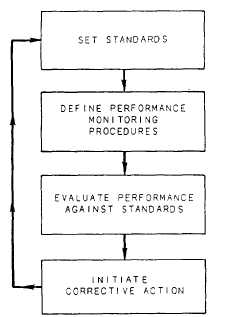Figure 4-3.-Steps to effective control.
STEPS TO EFFECTIVE CONTROL
The steps to effective control closely resemble
planning and organizing steps. See figure 4-3. The
following are the four basic steps to controlling:
1.
2.
3.
4.
Set standards
Define Performance monitoring procedures
Evaluate Performance against standards
Initiate corrective action
Set Standards
To establish control over a process, you must first
decide what standards you will use for reference points.
Standards define the goals of your efforts. They express
recruiting targets, quality control goals, budget goals, or
flight schedules. These are quantitative standards: 14
recruits a month, zero defects, 10 percent spending
reduction, or all aircraft full mission capable (FMC) for
a sortie. Other standards involve qualitative goals:
sharp uniforms, fair selection boards, or improved
morale. Qualitative standards are much more difficult to
define and control than quantitative standards.
Define Performance Monitoring Procedures
The next step in achieving control is deciding how
to measure performance, what information to require,
and how to obtain it. Performance data maybe gathered
from personal observation, written and oral reports,
inspections, and automatic data processing (ADP)
products. Keep control procedures as simple and
cost-effective as possible. Ensure, however, that they are
adequate for the task at hand.
Evaluate Performance Against Standards
Compare performance data to established
standards. The results of this comparison indicate where
you are in relation to your goals. If everything is on
track, take a bow. If things are beginning to stray off
course or come unraveled, decide whether or not to take
corrective action.
Initiate Corrective action
If performance standards are not being met, you
should start corrective action. Examine your monitoring
system; is it accurate?
Do performance standards
accurately reflect mission requirements? Are your
standards too high or too low? If your monitoring
methods and standards are adequate, examine the
production methods and work force factors (morale,
leadership, and so forth). Can production efficiency and
effectiveness be improved? Is training up to speed? Do
leadership and supervisory ability meet your standards?
How about morale and environmental conditions.
Another possibility is poor planning or organization.
You must go to work and get things moving in the right
direction again. After all, that is what managers do!
EVALUATING YOUR CONTROLS
Most commands have four key areas of control:
financial, inventory, quantity, and quality. Use the
following criteria to evaluate your command’s controls:
Timeliness–Controls must provide timely
detection and correction of problems to minimize
wasted time and resources.
Accuracy–Accurate monitoring procedures
allow you to pinpoint potential problems for
correction.
Acceptability–Controls must be reasonable.
Unnecessarily stringent controls generate resistance
within the work force. When workers feel there is no
trust or fail to understand the need for controls, they may
circumvent the system. You are no doubt familiar with
the term gundecking. You may even know someone
who has been guilty of gundecking.
4-14

